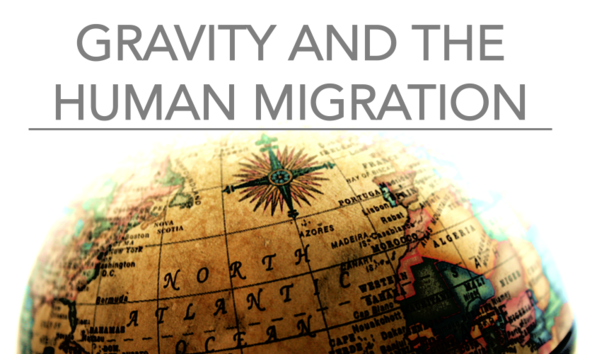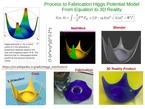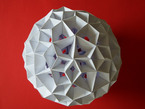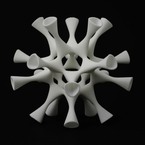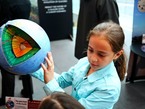Gravity and the Human Migration
체험활동
저작권
크레딧
- All authors worked on the literature review of migration - the mathematical modelling - the design of the exhibition - the creation of the materials - mounting the exhibition and displaying it in front of an audience.
Human migration is a topic that has commanded numerous column inches and news time in the past few years, and will probably continue to do so for some years to come. However, it is also a subject that suffers from misrepresentation and sensationalism: our perception of migration is heavily skewed by stereotypes that, aided by media reporting, have come to dominate our opinions at the expense of reliable data and statistics.
Chalkdust, a magazine for the mathematically curious (www. chalkdustmagazine.com), therefore developed an exhibit partly to challenge some of these perceptions and partly to show the application of mathematics in the social sciences and highlight the links between different fields of mathematics, thereby hopefully furthering the magazine’s goal of raising awareness of the beauty and importance of maths.
In particular, the exhibit shows how Newton’s discovery of gravity in 1687 has recently been applied to model migration, as well as other social behaviours such as trade.
When one mentions migration, the chances are that the first thing one thinks about is the movement (legal or otherwise) of Africans to Europe across the Mediterranean sea. This perception is often negative and is exacerbated by the publication of misleading or out-of-context data (if any is presented at all) in the media, or the subtle preconditioning to a certain viewpoint by the one-sided reporting of a certain issue, which perpetuates a viewpoint until it becomes commonly held and largely unchallenged. On top of this, there is the stereotype of Africa being a poor, rural continent, whose population wishes to leave en masse in search of a better life in the West.
This view, however, is far from true. Data (see the attached technical document) shows that most migration (not only within Africa but also globally) is from one city to a neighbouring city, or from the countryside to a nearby city or metropolitan area (98% of migrants are ‘internal migrants’, migrating within their own country). Certainly, the vast majority of migration is intra-continental rather than inter-continental. Furthermore, focusing specifically on Africa, it contains considerable urban areas and some of the world’s largest cities (Lagos and Cairo, for example, both have populations of around 20 million).
At Chalkdust, a magazine for the mathematical curious, we decided to develop an exhibit that could not only challenge these ideas and encourage the audience to seek out the data behind the stories, but (since we are a mathematics magazine) show how mathematical models indicate that the reality is far from counterintuitive.
The starting point was an apple that supposedly fell from a tree over three centuries ago…
Newtonian GravityIt is said that Newton’s eureka moment came as he was sitting under a tree and an apple fell on his head. This then led to his development of Newtonian gravity, published in July 1687 in his Philosophiae Naturalis Principia Mathematica. This states that there is a gravitational force of attraction between two objects, this force being proportional to the mass of each object and the square of the distance between them. The law is taught to every school student today, usually in physics lessons.
In the last few decades, an analogy of Newton’s law has been applied to models of social behaviour and particularly the pull of larger cities on smaller cities as a predictor of migration. In particular, larger cities (by, for example, population or GDP) have a larger ‘mass’ and therefore have a greater ‘gravitational force’ than smaller cities. This ‘gravitational pull’ however, decreases with increasing distance from the city so migrants are more likely to move to a closer city than one that is further away (depending also, as indicated just above, on the size). See the technical document for a more detailed description of the gravitational model of migration, references to its past applications, as well as some of its flaws.
This link between Newtonian gravity and migration can be easily visualised with a bedsheet, some weights, paint and not inconsiderable artistic talent!
Creating the exhibitAs indicated above, we chose to demonstrate how Newtonian gravity can be used to mathematically model migration by focusing on the continent of Africa, since much of the dialogue on migration is dominated by that continent and, notwithstanding this, considerable misconceptions still exist, as we shall see.
The creation of the exhibit is relatively straightforward, although a little time consuming, and we briefly describe it here: although we chose to show the continent of Africa, any geographical area could be used. We first obtained a bedsheet and, thankfully, gave it a wash. One never knows. We then drew the outline of the map of Africa on it and painted the interior using satellite images of the continent as a guideline. Please see the accompanying picture: we are in unanimous agreement that the Sahara desert is particularly well painted.
We then chose 23 of the largest cities in Africa (although their selection was also driven by a desire to ensure that there were not too many grouped closely together and that as many countries as possible were adequately represented). We used their population as the ‘mass’ of the city and created weights proportional to the population. See the technical document for a list of cities, their population and the weights used. These weights were then hung from the bedsheet in the (approximately) correct location of the city, which had the effect of distorting the map and creating valleys of attraction of varying radius and depth.
Particles (chickpeas, in our case) representing migrants can then be dropped onto the map by the audience, which then models their movement in a very visual way. Videos showing the creation of the exhibit and clips of our interaction with the audience are attached in the accompanying folder, although we must stress that the videos in which the students are visible are not for publication.
Behaviours witnessedThe particles dropped on the model behave in various ways, corresponding to the various behaviours seen in real life. As expected, of course, many move towards the larger nearby cities and fall into their ‘valleys’, which in turn increases the distortion of the map at those cities and gives them greater attraction. Others, on the other hand, remain where they fall and do not move to the cities. This could be due to many reasons and provokes a fruitful discussion with the audience. Motives given for staying put included family, a secure job, liking the neighbourhood, etc. This was a good opportunity to stress that most people (97% globally) do not migrate. There are also other external factors at play, including governmental policies that discourage migration. This provides one with a good opportunity to talk about the physical force of friction and its possible inclusion in the model.
The geography also plays an important part: particles that are dropped south of the Sahara rarely made it across the desert to the major city of Cairo, for example. This is repeated in real life. Further adaptations of the physical map (the bedsheet) can be made to include modifications for mountains, for example, that could also impede migration.
All in all, the various behaviours seen provide ample scope for discussion with the audience and, most of all, clearly indicate that most people, if they move, migrate to cities in the neighbourhood of their starting point.
Presentation to the audienceWe believe that the hands-on nature of our exhibit makes it particularly suitable for secondary school children, provided that they have learnt about Newton’s law of gravity and have some knowledge of other physical forces. Its conclusions, though are relevant to all ages. We tested the exhibit at the Greenwich Maths Time festival held at the University of Greenwich in June 2017. The audience at this event consisted largely of schoolchildren in years 10 and above, as well as their teachers.
The presentation was highly interactive with considerable audience participation and dialogue between presenters and audience. We began by asking them what was depicted on the bedsheet and what they knew about Africa. We then switched topic to gravity and asked them to explain it: some had seen videos of its representation as a distortion of an elastic sheet. Following this, we got them to lift the map and showed them the various cities and the dips created. Lifting the map still further, they could see the weights hanging down and were encouraged to think about what they might represent. This provides the beginning of the link to gravity.
They then dropped the chickpeas onto the map (which they thoroughly enjoyed) and surveyed their movement, which provided a discussion into their behaviour as described in the section above. This led them to the conclusion that not everybody moved and that people tended to be attracted to the largest nearby cities.
At this point, we challenged their perceptions of migration from Africa by asking them out of 100 Africans, how many they thought lived outside Africa. As a comparison question, we asked them the same question but for Europeans. Despite the demonstration just used and their conclusion that most people moved to nearby cities, the figures they gave were still far too high (some were over 50!) and, consistently, people believed that a greater percentage of Africans left Africa than Europeans left Europe. When we told them the actual data, published by the UN every year, which showed that only 1.4 out of 100 Africans currently reside out of Africa, compared with 3.2 Europeans out of 100 living out of Europe, they were universally astounded.
This led us to emphasise the importance of seeking out data and statistics behind reported stories and the need to challenge opinions with facts. We also discussed, through the presentation of the equation for gravity, how mathematics can be used, through even simple models, to understand the behaviour of nature and society. For an audience of schoolchildren, this is especially important, as they often have little awareness of its applications or how it permeates other subjects. Hopefully, it will lead some of them to pursue the subject in their future careers.
ConclusionIn conclusion, our exhibit shows the interrelation between different fields of mathematics, the application of the subject to areas where one might not expect it to have much to offer and highlighted misconceptions present in our society. We were hopefully able to change some of these views and demonstrate at the same time that what the data indicates is actually what one would expect.
And, of course, we had a fantastic time creating it and presenting it to our audience.
SubmissionWe created a blog on the Chalkdust website and for the submission, we created a website presentation. The videos for the submission in which there is an audience were recorded with a closed-zoom as no permit was obtained from the participants to publish their image.

